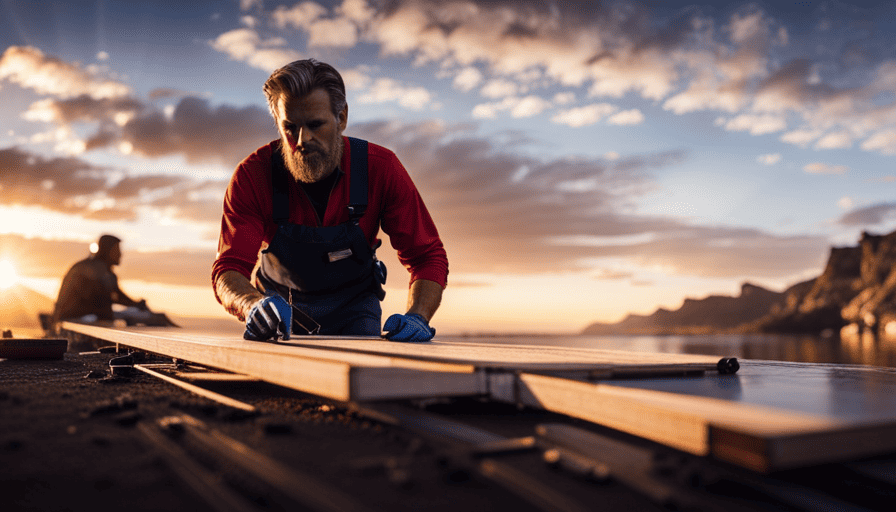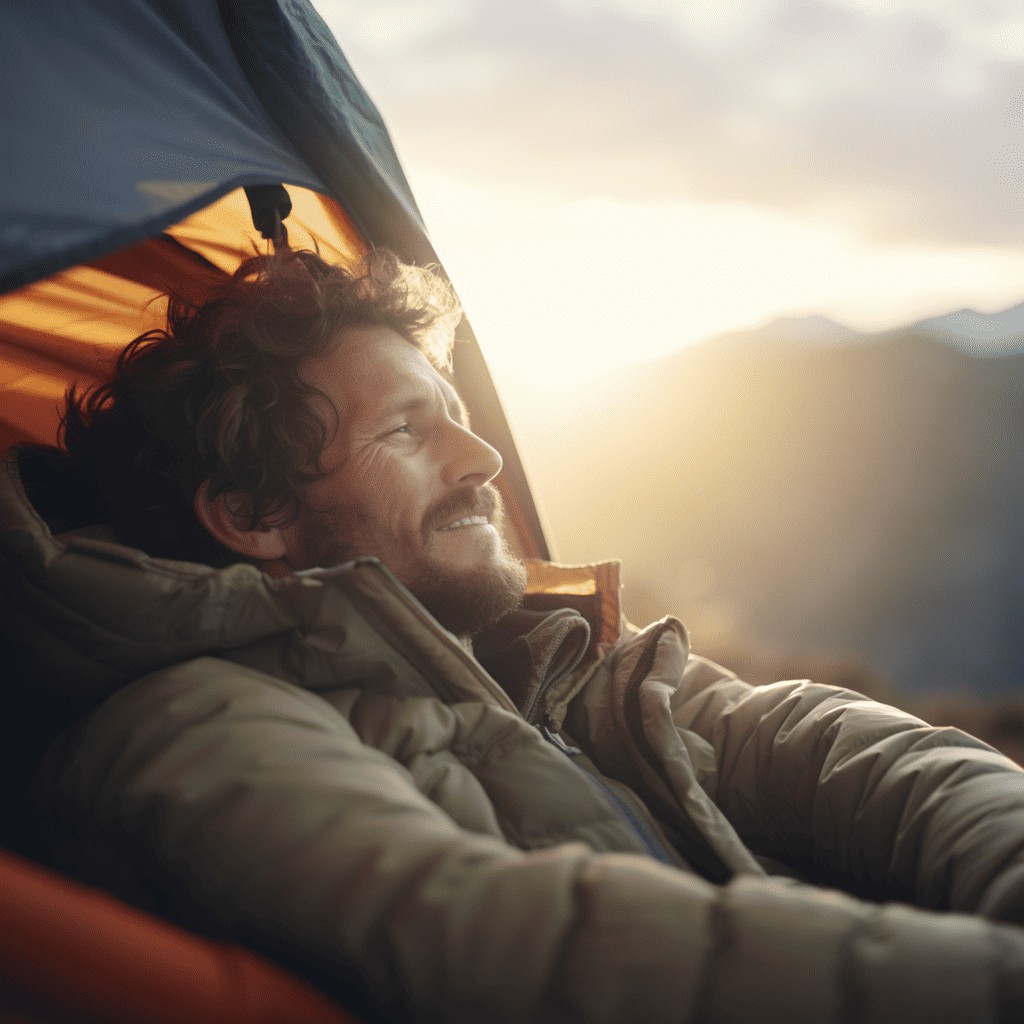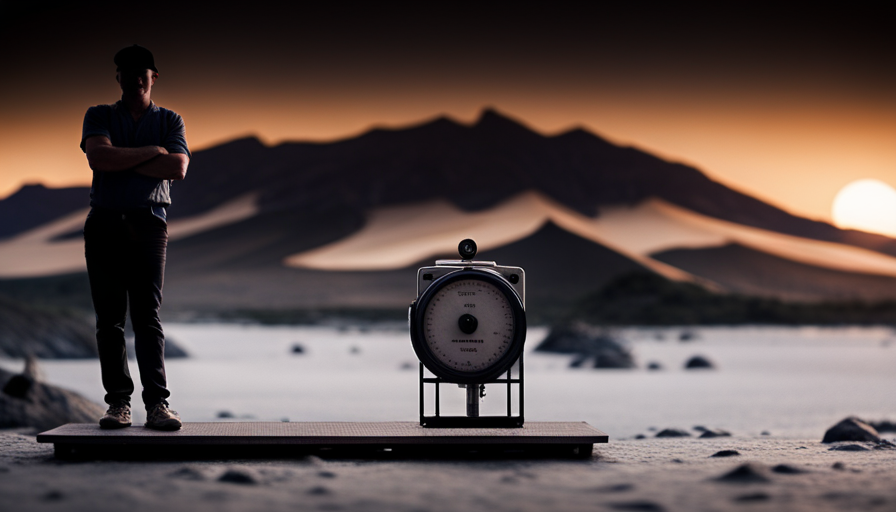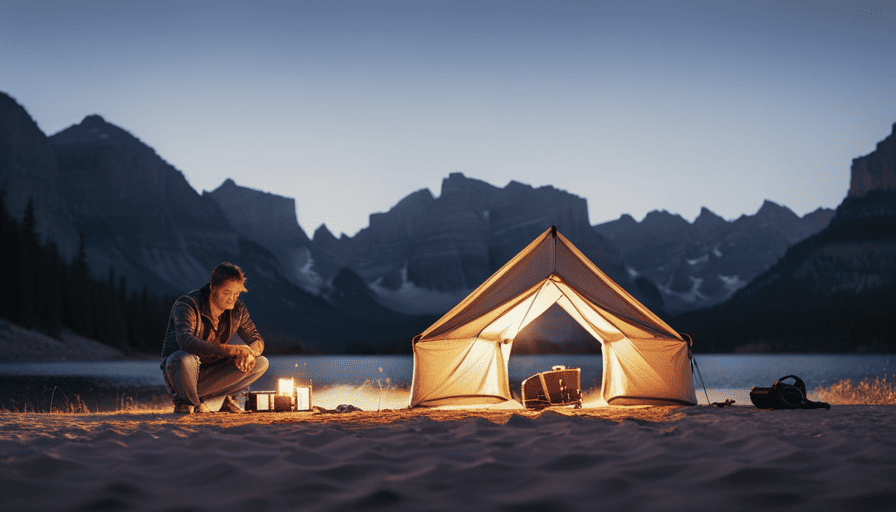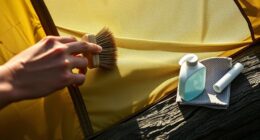You might be wondering. Constructing a camper trailer by yourself? It seems like a challenging and lengthy task. However, I assure you, it isn’t as overwhelming as you might think. Actually, with proper preparation, the correct tools, and the right materials, anyone has the ability to craft their very own personalized camper trailer.
Now, you might be wondering why you should bother building your own when you can simply buy one ready-made. Well, the answer is simple – building your own camper trailer allows you to design it exactly the way you want. From the layout and design to the storage solutions and exterior features, every aspect can be tailored to suit your needs and preferences.
In this article, I will guide you step-by-step through the process of building your own camper trailer. We will start by choosing the right trailer base and then move on to planning the layout and design. I will also provide a list of necessary tools and materials, as well as detailed instructions on building the frame and structure, installing electrical and plumbing systems, customizing the interior, and adding exterior features.
So, if you’re ready to embark on an exciting DIY adventure, let’s get started on building your dream camper trailer!
Key Takeaways
- Building your own camper trailer is not as complicated or time-consuming as it may seem, allowing you to design it exactly the way you want.
- Choosing the right trailer base is crucial for a successful build, considering personal preferences, requirements, and vehicle towing limits.
- Planning the layout and design is important to maximize space and functionality, incorporating multi-functional furniture and light colors for openness and warmth.
- Gathering necessary tools and materials, using sturdy materials for the frame, and taking essential safety precautions are essential for a secure build.
Choose the Right Trailer Base
Choosing the right trailer base is crucial in ensuring a successful camper trailer build, so don’t underestimate the importance of this decision. When it comes to trailer size, you need to consider your personal preferences and requirements. Do you want a compact and lightweight trailer for easy towing and maneuverability? Or do you need a larger trailer that can accommodate more people and provide additional storage space?
It’s essential to find the right balance between size and functionality. Trailer weight is another critical factor to consider. You don’t want a trailer that is too heavy for your vehicle to tow safely. Check the weight limits specified by your vehicle’s manufacturer and ensure your chosen trailer base falls within those limits. Keep in mind that the weight of the trailer will increase once you add all the necessary camping equipment and supplies.
When you have chosen the right trailer base, it’s time to plan the layout and design. This step involves deciding on the location of key components such as the bed, kitchenette, bathroom, and storage areas. Consider your lifestyle and camping preferences to create a layout that maximizes space and functionality.
So, let’s move on to planning the layout and design, where we can dive deeper into customizing your camper trailer to suit your needs.
Plan the Layout and Design
When mapping out the blueprint for your camper trailer, it’s crucial to consider the layout and design to ensure maximum functionality and comfort. The furniture placement plays a significant role in optimizing the available space. Start by identifying the essential pieces, such as a bed, kitchenette, and dining area, and determine their optimal positions.
Consider utilizing multi-functional furniture, such as a sofa bed or collapsible table, to maximize space utilization. Additionally, think about the flow of movement within the trailer and ensure that there is enough space to move comfortably between the different areas.
Incorporating decorative elements can add a personal touch to your camper trailer. Consider using light colors and patterns to create a sense of openness and warmth. Hang artwork or photos on the walls to make the space feel homier. Utilize curtains or blinds to provide privacy and control the amount of natural light entering the trailer. Remember to keep the decorative elements simple and lightweight, as space and weight are limited in a camper trailer.
When planning the layout and design, keep in mind that the furniture and decorative elements should not only be aesthetically pleasing but also functional and practical. The goal is to create a space that is comfortable and efficient for living and traveling.
Now that the layout and design are planned, it’s time to gather the necessary tools and materials to bring your camper trailer to life.
Gather the Necessary Tools and Materials
Once you’ve gathered all the essential tools and materials, you’ll be well on your way to transforming your vision into a reality, making your dreams of adventure and coziness come true. Choosing the right materials and tools is crucial for the success of your camper trailer project. For the structure, you’ll need a sturdy frame made of steel or aluminum, depending on your preference and budget. Additionally, you’ll require plywood or composite panels for the walls, roof, and floor. These materials are lightweight yet durable, perfect for a camper trailer.
To ensure your safety throughout the construction process, it’s important to take essential safety precautions. Always wear protective gear such as gloves, goggles, and a dust mask when working with tools and materials. Keep a fire extinguisher nearby and have a first aid kit readily available. Familiarize yourself with the proper use of each tool and follow the manufacturer’s instructions.
Now that you have all the necessary tools and materials, you can begin building the frame and structure of your camper trailer. This stage will lay the foundation for the rest of the construction process, ensuring stability and durability.
Build the Frame and Structure
Now that I have all the necessary tools and materials, it’s time to bring my vision to life and embark on the journey of constructing an adventure sanctuary on wheels. Building the frame and structure is a crucial step in creating a sturdy and reliable camper trailer. There are various building techniques that can be utilized, such as welding, bolting, or screwing the frame together. Safety precautions must always be taken, including wearing protective gear and ensuring that the structure is stable and secure before proceeding.
First, I start by measuring and cutting the frame pieces according to the design specifications. Then, I assemble the frame using the chosen building technique, making sure all joints are secure and tight. Reinforcing the corners and adding cross-bracing can provide additional strength and stability. I also make sure to check for any sharp edges or protruding nails that could cause injury.
Once the frame is complete, I move on to building the walls and roof. This can be done using plywood or other suitable materials. It’s important to properly insulate the walls for better temperature control and noise reduction. Additionally, I install windows and doors, ensuring they’re properly sealed to prevent leaks.
Now that the frame and structure are in place, it’s time to move on to the next step: installing electrical and plumbing systems.
Install Electrical and Plumbing Systems
To ensure a functional and comfortable living space, it’s essential to install electrical and plumbing systems in the adventure sanctuary on wheels.
When it comes to electrical safety, there are a few key considerations. First, make sure to use a circuit breaker panel to protect your camper from electrical overloads. It’s also important to follow proper wiring techniques and use the appropriate gauge wire for each circuit. Don’t forget to install ground fault circuit interrupters (GFCIs) in areas where water is present, such as the kitchen and bathroom, to prevent electric shock.
When it comes to plumbing maintenance, there are a few things to keep in mind. Use high-quality pipes and fittings to prevent leaks and ensure longevity. Additionally, consider installing a water filtration system to provide clean, fresh water on the go. Don’t forget to properly insulate your pipes to prevent freezing in colder temperatures.
Now that the electrical and plumbing systems are in place, it’s time to focus on adding insulation and ventilation to our camper trailer.
Add Insulation and Ventilation
Creating a cozy and breathable environment inside your adventure sanctuary on wheels involves incorporating insulation and ventilation. Insulation is crucial to regulate temperature and reduce noise, while ventilation ensures fresh air circulation. When it comes to insulation, there are various types to consider. Foam board insulation is a popular choice due to its excellent insulation properties and ease of installation. Reflective insulation, such as radiant barriers, is effective in reflecting heat away from the camper, keeping it cooler in hot weather. Fiberglass insulation is another option that provides good thermal protection.
To provide a visual guide, here is a table showcasing different insulation types:
| Insulation Type | Pros | Cons |
|---|---|---|
| Foam Board | Excellent insulation, easy installation | Can be expensive |
| Reflective | Reflects heat, keeps camper cooler | May not provide sufficient insulation |
| Fiberglass | Good thermal protection | Can be itchy, requires protective gear during installation |
In addition to insulation, proper ventilation is vital for a comfortable camper. Ventilation options include roof vents, which allow hot air to escape, and windows that can be opened for fresh air circulation. Installing a fan, such as a ceiling or exhaust fan, also helps in maintaining airflow.
With insulation and ventilation in place, your camper will be a cozy and comfortable haven. Now, let’s move on to the next section and explore how to customize the interior of your camper.
Customize the Interior
Transforming the interior of your adventure sanctuary on wheels will truly make it feel like a personalized, cozy retreat. When it comes to customizing the decor of your camper trailer, there are endless possibilities to make it reflect your own style and taste.
Start by choosing the right furniture that not only fits the space but also provides comfort and functionality. Opt for multi-purpose pieces such as a sofa that can be converted into a bed or a dining table that can be folded when not in use. This will help optimize the limited space available in a camper trailer.
Consider the color scheme of your interior as well. Lighter shades can create an illusion of more space, while darker tones can add a touch of elegance and coziness. Incorporate elements that bring nature inside, such as leafy plants or nature-inspired artwork, to create a calming and refreshing ambiance.
As you customize the interior, think about the storage solutions you will need. Utilize every nook and cranny by adding shelves, hooks, and storage bins to keep your belongings organized and easily accessible. By creating smart storage solutions, you can maximize the functionality of your camper trailer.
Transitioning to the next section about creating storage solutions, let’s explore how to efficiently utilize the available space in your camper trailer without compromising on style or comfort.
Create Storage Solutions
When it comes to creating storage solutions in my own camper trailer, I’ve found that maximizing space with built-in storage is essential. By utilizing every nook and cranny of the trailer, I’m able to store all of my belongings efficiently.
In addition, I’ve found that utilizing storage containers and bins is a great way to keep everything organized and easily accessible. With these strategies in place, I’m able to make the most of the limited space in my camper trailer and ensure that everything has its own designated place.
Maximize Space with Built-In Storage
To optimize the limited space in your camper trailer, you’ll want to maximize storage by incorporating built-in compartments and cleverly hidden cubbies. Here are five space-saving solutions and creative organization hacks to make the most of your camper’s interior:
- Install foldable furniture pieces, such as a Murphy bed or collapsible dining table, to save space when not in use.
- Utilize vertical space by adding shelves or hanging storage racks on walls and inside cabinets.
- Use multi-purpose furniture, like ottomans with hidden storage compartments or benches that double as storage units.
- Install magnetic strips or hooks on the walls to hang and store small items like kitchen utensils and keys.
- Opt for storage solutions with built-in dividers or adjustable shelves to maximize the use of every inch of space.
By incorporating these space-saving furniture ideas and creative organization hacks, you’ll create a camper trailer interior that’s both functional and efficient.
Speaking of efficient storage solutions, in the next section, we’ll explore how to utilize storage containers and bins to further optimize your space.
Utilize Storage Containers and Bins
Make the most of your camper’s limited space by using storage containers and bins. Storage organization is key when it comes to maximizing space in your camper trailer. By utilizing storage containers and bins, you can effectively organize and optimize the available space. These containers and bins come in various sizes and shapes, allowing you to customize your storage solutions according to your needs. Use them to store kitchen essentials, clothing, camping gear, and other items you’ll need on your travels. To give you an idea of how these storage solutions can work for you, here’s a helpful table:
| Container/Bin Type | Purpose |
|---|---|
| Plastic storage bins | For storing bulky items like camping chairs and outdoor equipment |
| Stackable drawers | Ideal for organizing clothes and accessories |
| Collapsible storage containers | Great for storing items that aren’t frequently used |
By incorporating these storage containers and bins into your camper, you’ll be able to keep everything neatly organized and easily accessible. Now, let’s move on to the next section and explore how to add exterior features to your camper trailer.
Add Exterior Features
When it comes to adding exterior features to your camper trailer, there are a couple of key points to consider.
First, installing awnings or canopies can provide much-needed shade and protection from the elements. This is especially useful during hot summer days or when it’s raining.
Additionally, adding bike racks or roof racks can greatly enhance your camper trailer’s versatility, allowing you to bring along bikes or extra gear for outdoor activities.
These features are practical and can greatly improve your camping experience.
Install Awnings or Canopies for Shade
Transform your camper trailer into a shady oasis by easily installing awnings or canopies. When it comes to choosing between awnings and canopies, there are pros and cons to consider.
Awnings are attached to the side of the trailer and can be extended or retracted as needed. They provide a more permanent shade solution and are generally more durable.
On the other hand, canopies are freestanding structures that can be set up anywhere around the trailer. They offer flexibility in terms of placement and can be easily removed when not in use.
There are different types of shade options available, including manual and automatic awnings, as well as pop-up canopies. Each option has its own benefits and it ultimately depends on your preferences and camping style.
Now, let’s consider adding bike racks or roof racks to further enhance your camper trailer’s functionality.
Consider Adding Bike Racks or Roof Racks
Enhance your camper trailer’s versatility and freedom of exploration by adding bike racks or roof racks, unlocking the potential for endless adventures on two wheels.
When it comes to bike rack options, there are various styles to choose from. Hitch-mounted racks are popular as they offer easy loading and unloading, but they can obstruct access to your trailer’s rear. Roof-mounted racks, on the other hand, keep the rear accessible but require lifting the bikes onto the roof, which can be challenging for some. Consider your needs and preferences before making a decision.
As for roof racks, they provide additional storage space for bulky items like kayaks or surfboards. However, they can increase the overall height of your trailer, making it more challenging to navigate under low bridges or tree branches. By carefully considering the pros and cons of these options, you can find the best solution for your camper trailer.
With bike racks or roof racks in place, you’ll be ready to hit the road and explore new destinations.
Transitioning into the next section, let’s now discuss how to test and enjoy your camper trailer.
Test and Enjoy Your Camper Trailer
Once you have completed the construction of your camper trailer, you can begin to test it out and fully enjoy all of its amenities. Testing the durability of your camper trailer is an important step before embarking on any camping trip. Take it for a spin on different terrains and see how it holds up. This will give you an idea of any areas that may need reinforcement or improvement. Additionally, it’s crucial to find the best camping spots that suit your preferences. Whether you prefer a scenic mountain view or a serene beachfront, exploring different locations will help you find your favorite spots. To help you in your search, I have created a table below with three columns: Location, Amenities, and Terrain. This table will assist you in keeping track of the different camping spots you’ve visited and their unique features. By testing and enjoying your camper trailer, you’ll not only ensure its durability but also create memorable adventures in the great outdoors.
| Location | Amenities | Terrain |
|---|---|---|
| Mountain Valley | Water, Electricity | Hilly |
| Beachfront | Restrooms, BBQ grills | Sandy |
| Forest | Fishing, Hiking Trails | Wooded |
| National Park | Campfire pits, Wi-Fi | Rocky |
| Lakeside | Boat rentals, Picnic | Grassy |
Frequently Asked Questions
How much does it cost to build a camper trailer?
Building a camper trailer is like embarking on a journey to create your own oasis on wheels. When it comes to cost, the breakdown includes factors like materials, appliances, and labor. Budget considerations are crucial, as they determine the quality and features you can afford.
To give you an idea, a basic DIY camper trailer can cost anywhere from $2,000 to $10,000, while a more luxurious one can range from $10,000 to $30,000 or more, depending on your preferences.
Can I use any type of trailer as a base for building a camper trailer?
Yes, you can use any type of trailer as a base for building a camper trailer. Customizing a trailer allows you to create a camper that suits your needs and preferences. When choosing the right materials, it’s important to consider durability, weight, and insulation.
For example, using lightweight aluminum for the frame and fiberglass for the walls can provide strength and insulation while keeping the overall weight low.
Do I need any specific skills or experience to build a camper trailer?
Skills required to build a camper trailer include basic carpentry, electrical, and plumbing skills. Experience in working with power tools and reading blueprints is also helpful. Attention to detail and problem-solving abilities are crucial throughout the process. It’s important to have a good understanding of structural integrity and safety regulations.
While experience in building trailers is not necessary, it can be beneficial. With the right skills and experience, building a camper trailer can be a rewarding and fulfilling project.
How long does it typically take to build a camper trailer?
When planning a camper trailer build, it’s important to consider the time it will take to complete. The duration can vary depending on factors such as your level of experience, the complexity of the design, and the availability of resources. However, as a general guideline, it can take anywhere from a few weeks to several months to build a camper trailer.
To ensure a successful build, I recommend creating a detailed plan and customizing your trailer with practical features that suit your needs and preferences.
Are there any legal requirements or regulations I need to consider when building a camper trailer?
When building a camper trailer, it’s crucial to consider the legal requirements and regulations.
Insurance requirements vary depending on your location, but it’s generally recommended to have liability coverage to protect yourself and others on the road.
Safety regulations are also important to ensure the well-being of occupants. These may include guidelines for weight limits, lighting, braking systems, and emergency exits.
Familiarizing yourself with these requirements will help you build a camper trailer that meets all necessary regulations.
What Are the Steps to Building a Camper Trailer?
Building a camper trailer involves several steps. First, measure and design the trailer according to your needs. Next, gather materials and tools like lumber, screws, and electrical components. Construct the trailer frame and attach the flooring. Install the walls, roof, and windows, ensuring proper insulation. Then, focus on the electrical and plumbing systems. Lastly, personalize the interior and add necessary amenities to create your dream build a camper trailer.
Conclusion
After months of hard work and dedication, my very own camper trailer is complete. It’s a testament to the power of DIY and the satisfaction that comes with creating something from scratch.
The journey wasn’t always easy, but the end result is truly worth it. From choosing the perfect trailer base to customizing the interior and adding exterior features, every step was carefully planned and executed.
Now, I can’t wait to hit the open road and experience the freedom and adventure that comes with owning my own camper trailer.

